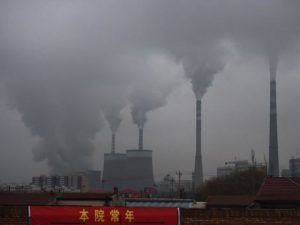The world’s factory, otherwise known as China, fills big box America from Costco to Target to Walmart.
From Home Depot to Lowe’s the world’s factory supplies America with the suburban necessities.
If it’s electronic components, or sporty textiles, or steel, look for the Made in China tag. You won’t have to look very hard.
Being tagged The World’s Factory is a badge of honor, but it comes with a stain that might not wash out.
I’ve seen pictures of air pollution days in China that look like a blue fog. Here in Portland we have things called temperature inversions that look like a brown fog. Not the same.
Portland is not the world’s factory, but the industrial NW and NE still kick ass. The difference is cost.
There’s not an over abundance of skilled and motivated hipsters, millennials, or the next population bulge fighting for the lowest paying jobs, working multiple shifts in world’s factory style conditions, and getting paid once a year to hold them hostage.
China has that and more, like child labor laws that allow children to man the world’s factory with their tiny fingers that reach small places on a mother board. Working children cuts down child care expenses, and that also fits into the final big box price of goods.
Imagine your ten year old bringing money into the household instead of running up costs on a licensed daycare.
I’m not suggesting the twenty dollar shovel with the Made in China label was made by babies, but there is a connection.
If you’ve seen steel production up close and personal, then you understand. I’ve seen a bronze foundry and that was messy enough.
The world’s factory needs to make steel or they lose the title. The world needs cheap steel, but the cost is financial and environmental. That twenty dollar shovel isn’t forty because the sort of pollution associated with steel isn’t dealt with the same way in China as it is here.
Pittsburgh, the Steel City, knows the drill.
In his recent book ‘Behemoth: A History of the Factory and the Making of the Modern World’, Joshua B. Freeman catalogues the world’s factory history from London to Detroit to Shenzhen.
This is a passage from his Time piece on the world’s factory life cycle:
Today we are seeing this cycle again, at a faster-than-ever pace, in China. Though many Americans bemoan the loss of factory jobs to China, factories built when China opened itself up to foreign investment during the 1980s are beginning to shutter. The Shenzhen region, epicenter for the explosion of Chinese export-oriented manufacturing, already has reached its peak as a center for large-scale production, just 30 years after electronics assembler Foxconn – which operates the largest factories in human history – opened its first plant there.
I’m not saying, “Step away from the iPhone,” or, “Don’t drive across the Bay Bridge.”
This isn’t that blog. Instead I choose to remind readers of the costs of big box America. Made in China has a hidden cost that’s getting more and more attention.
We like the twenty dollar shovel and the smart phone. We feel smart, but know the sourcing.
Foxconn company store?
“They call Foxconn a fox trap,” he says. “Because it tricks a lot of people.” He says Foxconn promised them free housing but then forced them to pay exorbitantly high bills for electricity and water. The current dorms sleep eight to a room and he says they used to be 12 to a room. But Foxconn would shirk social insurance and be late or fail to pay bonuses. And many workers sign contracts that subtract a hefty penalty from their pay if they quit before a three-month introductory period.
Longhua culture?
Today, the iPhone is made at a number of different factories around China, but for years, as it became the bestselling product in the world, it was largely assembled at Foxconn’s 1.4 square-mile flagship plant, just outside Shenzhen. The sprawling factory was once home to an estimated 450,000 workers. Today, that number is believed to be smaller, but it remains one of the biggest such operations in the world. If you know of Foxconn, there’s a good chance it’s because you’ve heard of the suicides. In 2010, Longhua assembly-line workers began killing themselves. Worker after worker threw themselves off the towering dorm buildings, sometimes in broad daylight, in tragic displays of desperation – and in protest at the work conditions inside. There were 18 reported suicide attempts that year alone and 14 confirmed deaths. Twenty more workers were talked down by Foxconn officials.
We dig holes and make phone calls and work through each day without thinking about where the tools come from.
Now we do, and have to ask a few questions:
-
Do we want to pay more for lower quality?
-
If we do pay more will workers be better treated?
-
What are we willing to be priced out of?



